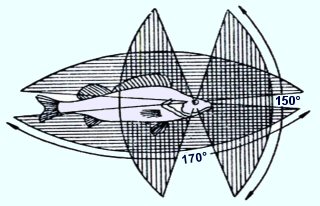
ECOLOGY OF FISH
A combination of understanding the fish and the techniques used to catch them will help you to hook more fish to the end of your line. Better knowing and understanding of the fish that you are trying to catch will make you a more successful angler, whether you are fishing for trout on a river or surfing on the beach or trolling on the open water.
Ecology of fish represents a section of ichthyology, the study on fish life, namely: the nature of the dynamics of their populations, intraspecific (flocks, shoals, the colony) and inter-specific groups, distribution, migrations, circadian and seasonal rhythms of life, the nature of food relations, reproduction, etc. Ecology explores the daily, seasonal and life cycle of fish, the nature of its relationship with abiotic and biotic environment. The life of the fish (any organism) are inextricably linked to its structure and function of organs. Because the shape, function, and animal life are inextricably linked, the knowledge of its structure and functions of its organs, knowledge of its lifestyle, the adaptive nature of its relationship with the environment are very important.
Body composition of fish and their movement
Each species is adapted to life in a specific habitat. The body of the fish, ranging from body shape and ending with the breathing apparatus and sense organs, adapted to the conditions of life in the water, adapted to the movement in the water. The body shape is one of the best indicators in determining the fish's environment. The typical body shape of a fish - spindly, where water has the least resistance. The Head feels part of the body from, the snout tip to the end of the gill covers. The trunk continues to the anus. The tail is divided into the caudal peduncle and caudal fin. The body of the fish out of water, covered with slime. Mucus is needed for protection from pests and to reduce friction when moving in the water. The skin has scales, like a shell. The number of scales increases with the host, so the age of fish can be determined by the annual rings as on the stump of a tree. The circulatory system of fish is closed, it consists of one heart and circulation. In the upper part of the body under the spine there are two red-brown buds (often incorrectly referred to as blood). In the kidneys from the blood are filtered decay products.
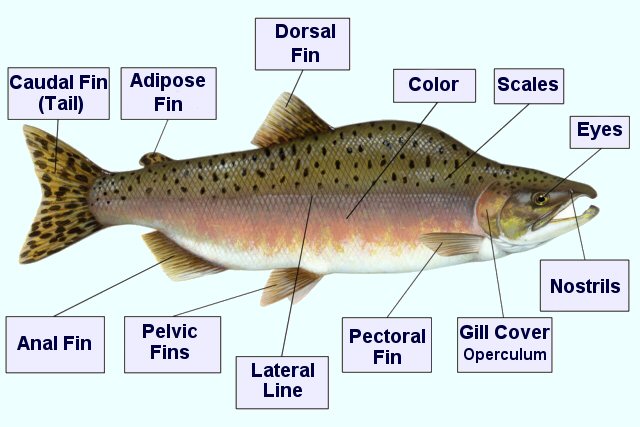

There are different shapes of the body have species that live on the bottom and top layers of water. For example, surface dwelling fish have an upturned mouth, a flattened back. The bottom fish (flounder, catfish, burbot, bull) have the body flattened, allowing them to rely on a large ground surface, are adapted to life in slow-moving waters. Slender, torpedo shaped fish are better adapted to moving waters. Bottom-dwelling fish have flattened bellies and inferior mouths. Some bottom-dwellers have altered swim bladders so they "hop" along the substrate instead of swimming. Sometimes the fish adapt to passive movement. Leaf-shaped larvae of the eel makes it easier to transfer over to the spawning eels, located off the coast of Central America, to places of permanent habitation in the waters of Europe. In cases where the fish is almost not moving, part of the body including the tail into a body attachment (seahorse). Some influence on the shape of the body has nutrition, for example, predatory fish, which catching prey, has the longer, slimer body shape than fish eating sticky foods.
There are three general locations of the mouth in fish which often indicate the species's feeding habits. Surface feeding fish usually have an undershot, upturned (superior) mouth for feeding on insects. Fish that feed in mid water have a terminal mouth, which is usually considered the "normal" fish mouth. Predatory fish usually have a wide mouth, while omnivorous fish have smaller mouths. Bottom feeding fish generally have an underslung or inferior mouth. Often, bottom feeding species are also equipped with barbels ("whiskers"), which are tactile and taste organs used for locating food in dark or muddy waters. Some bottom-dwelling fish, especially the Loricarids, have a suction-cup like mouth for rasping on algae, wood, plants, or mud (for small invertebrates).
Fish need to move to find food and escape from enemies. However, water has a significant resistance to their movement. Therefore, during the evolution of most fish purchased a streamlined body shape, making it easier to overcome the resistance of the aquatic environment. The most perfect streamlined body-through fish are committing far migration, such as salmon. Almost the same terete or fusiform body, a powerful tail and medium-sized scales in fish, constantly living on the rapids (trout, minnow, osman, barbel, etc.). Sometimes some fish (roach, ide), living in the headwaters of the river on a fast course, have a trunk terete than fish of the same species that inhabit the estuary, where the flow is slower. Broad, high-body fish live in quiet waters, because they do not have to fight over, in addition, such a body shape helps them to better avoid predators, are less willing to grasping large fish.
Fish move through the undulating body movements. The progressive movement of fish is predominantly undulating curves of the body. The swiming bladder keeps the body in balance, so that it floats in water. The fish have fins, which are used for traffic control and braking. They can be paired and unpaired. The highest value of the motion has the caudal fin: the tail hitting the right and left, the fish moves forward. The role of other fins reduces mainly to coordinating and directing the functions. The dorsal and anal fins play a role keels, help the fish to keep a balance, maintain a normal body posture and movement make a straight line. Paired pectoral and pelvic fins are functions of rudder rotation and depth, they are used for turning, moving back and braking, as well as help keep the balance. Caudal fin moves from side to side and pushes the fish forward. Adipose fin has no apparent purpose; it has rays and characterizes the fish.
Back to top
Fish breathe
Like humans, fish need to breathe oxygen to maintain life processes. Most fish breathe oxygen dissolved in water. At a time when we inhale oxygen from ambient air, the fish gets it needs oxygen from the water that flows through their mouth and passed through the gills. Gills are the main respiratory organs located in the pits just behind the head. They consist of a set of plates and thin layers of the skin that pick up oxygen from the water. The shape and the surface area of the gills, the structure of the gill slits and the mechanism of the respiratory movements depend on the life of fish. The fish, floating in polvody, large gill slits and gill filaments always washed with fresh water, rich in oxygen. At bottom fish - eels, flounder - gill slits small (otherwise they can become clogged with silt) with means for forced circulation of water.
Fish that live in water, oxygen-poor, have more respiratory organs. Carp and other fish with a lack of oxygen in the water swallow the air and use it to enrich water with oxygen.
In tench, catfish and eel have extra skin breath. In the respiratory functions involved perch swim bladders, while Loach - intestine. Some warm-water fish are endowed with bodies, allowing itself to breathe atmospheric air. In some fish a special labyrinth apparatus, the others - turned into a respiratory air bladder.
In accordance with the structure of the respiratory organs of fish in different ways relate to the amount of oxygen dissolved in water. Some fish need a very high content in water - salmon, whitefish, trout, pike, while others are less demanding - roach, perch, pike, and the third being met entirely negligible amount of oxygen - carp, tench. There are at least defined for each fish species threshold oxygen content in water, below which individuals of this species become sluggish, almost not moving, malnourished and eventually die.
Oxygen enters the water from the atmosphere and is excreted by aquatic plants, with the latter, on the one hand, release it when exposed to light, but on the other - is taken up in the dark, and spend at rotting. Therefore, the "positive role of plants in the oxygen mode is noticeable only during their growth, ie, in the summer, and though the day.
From the air the water is enriched with oxygen around the clock. Intensity of dissolution of oxygen depends on water temperature, quantity of water surface in contact with air, and the mixing of different layers of water. The lower the temperature, the greater the water surface and intensive mixing, the better the oxygen dissolved in water. Therefore, the decrease in summer temperatures and high winds contribute to improving the well-being of fish, especially in waters with low oxygen content. After the rain also increased the activity of fish, and quickens the biting. Oxygenates raindrops increase the total content in the pond.
Oxygen slowly penetrating one water layer to another, and in the surface layers is always higher than near the bottom. This is one of the reasons for the weak development of life and lack of accumulation of fish in the summer at depths, especially in stagnant waters.
The lakes have areas with greater and lesser oxygen concentration. For example, the wind blowing from the shore, steal oxygen-rich upper layers of water, and in their place comes a little oxygen-rich deep water. Thus, Zatyshne coast creates a low content of oxygen zone, and fish, ceteris paribus, prefers to stay at the surf beach. A characteristic example is the behavior of Lake Ladoga kislorodolyubivogo grayling, which approaches the shore mainly at steady winds blowing from the lake.
The oxygen regime is deteriorating in stagnant ponds in the winter when ice cover prevents access of air to water. This is especially noticeable in the shallow, heavily overgrown ponds with muddy or peaty bottoms, where the supply of oxygen consumed for oxidation of various organic residues. In winter, the area with varying oxygen concentrations found in the lakes more frequently than in summer.
More oxygen-rich areas with rocky or sandy bottom, near the exit of key water at the confluence of streams and rivers. These places usually selects fish for winter camps. In some lakes, especially in harsh winters, the oxygen content in water drops so that there comes a mass death of fish - the so-called Zamora.
In the rivers, especially the fleeting, nor summer, nor winter, a sharp natural oxygen deficiency is not observed. However, in rivers, contaminate waste timber rafting and polluted industrial wastewater, this flaw is so great that the oxygen-demanding fish completely disappear.
Back to top
Fish Sense organs
Vision. Fish eyes could see in all directions. Each eye works by itself, so the fish can look forward and back simultaneously. In the eyelids and lacrimal glands is not necessary. In water, the eye is constantly wet and clean. It is important to note that most fish are short-sighted, and use other senses to detect food at a distance, and then swim up close to visually identify it. They have large eyes, eyes that do not react to light. Thus, the fish prefer shaded areas.
Optical properties of the water environment do not allow the fish to see well. Practical limit of visibility in fish in the clear water say a distance of 10-12 meters, and it is clear the fish can see no further 1,5 m. It is better to see the prey fish living in clear water (trout, grayling, chub, pike). Some fish can see in the dark (perch, bream, catfish, eel, burbot). They are in the retina has special light-sensitive elements that are able to perceive the weak light beams.

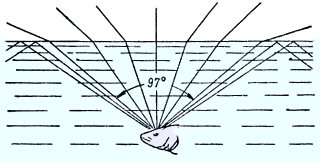
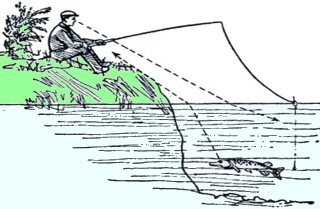
Color vision in fish is confirmed by their ability to change color depending on the color of the soil (mimicry). It is known that perch, roach, pike, which are kept on a light sandy bottom, have a light color and a black peaty bottom - darker.
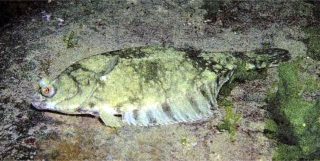
Hearing. The organs of the inner ear and swim bladder can capture sound in water.
Fish react to sound, these reactions are perceived and auditory labyrinth, available at the head of fish, and the skin surface, and swim bladder, which acts as a resonator. Fish capture the sounds worse than a man, with a higher tone of the fish can hear better than low. Sounds that occur in the aquatic environment, fish can hear at a considerable distance, and the sounds that occur in the air, heard a bad thing because the sound waves reflected from the surface and poorly penetrate into the water. Given these characteristics, the angler must beware of making noise in the water, but can not be afraid to scare the fish, talking loudly.
Body lateral line. Most fish have a line running along both sides of the body. The lateral line has a few openings that capture low-frequency vibrations and pressure changes around the body of the fish. Lateral line organ is only in fish and amphibians, constantly living in the water. Lateral line often represents a channel that runs along the body from head to tail. In the channel branch nerves, with great sensitivity perceive even the smallest water fluctuations. With this body of the fish determine the direction and force of the flow, feel the currents of water formed by the flushing of underwater objects, feel the motion of a neighbor in a pack, enemies or prey, the excitement on the water surface. In addition, the fish perceives and vibrations that are transmitted from outside the water - shaking the soil blows on a boat, a blast wave, the ship hull vibration, etc.
It is able to perceive the currents of water and reflection from objects. The lateral line helps fish to hide from enemies and gather food.
Studied in detail the role of the lateral line in fish-catching prey. Repeatedly raised experiments have shown that blinded pike is well oriented and accurately grasp a moving fish, not paying attention to fixed. Blind pike with damaged lateral line loses the ability to orientation, stumbles on the pool wall and being hungry, do not pay attention to the floating fish.
Given this, the observer should behave with caution and on the shore and the boat. Concussion of the soil under their feet, a wave of sloppy movement in the boat and can alert the long spooks the fish. Not indifferent to the success of catching the motion of the water lures as well as predators in the pursuit and grasping prey feel it creates water fluctuations. Catchability, of course, be those lures that best reproduce the symptoms of common predators.
Organs of smell and taste. Fish see with their eyes, but much better feel the smell. Organs of smell and taste in fish are separated. Olfactory organ in teleosts are paired nostrils are located on both sides of the head and leading into the nasal cavity lined with olfactory epithelium. In one hole the water comes in and goes out another. This device allows the fish olfactory organs of smell dissolved or suspended in water substances, and on the course of the fish can smell only a jet carrying the odorous substance, but in tihovode - only in the presence of currents of water.
Olfactory organ is weaker than most developed in the prey fish (pike, chub, perch), stronger - at night and twilight of fish (eel, catfish, carp, tench).
Gustatory organs are located primarily in the mouth and pharyngeal cavity, in some fish taste buds are in the lips and mustache (catfish, burbot), and sometimes are located throughout the body (carp). Experiments show that fish are able to distinguish sweet, sour, hot, "and something salty. Just like the smell, the sense of taste is stronger developed nocturnal fish.
The natural smell of fresh bait, particularly hemp seed cake, hemp and sunflower oil, rye crackers, freshly cereal, no doubt attracts the fish, and speeds up its approach to the feeder.
Back to top
How water temperature and pressure are impact on the fish
Fish belong to animals that have a variable body temperature. It varies with changes in ambient temperature and is only a few tenths of a degree above it. Only in the tuna's body temperature may be hotter than the surrounding water environment at 8-9°C. Therefore, temperature change (eg, transplant fish from one basin to another by the difference in temperature 4-5°) causes their illness and often death. The gradual rise or lowering the temperature of the fish are able to move without special effects. There is a fish dahlia in the streams and shallow lake of Chukotka Peninsula, which freezes at the freezing water and revived when thawed. But this is certainly an isolated example, usually the same fish can not tolerate such a wide temperature fluctuations.
Temperature has great influence on the vital functions of fish. Each kind of shows the greatest ability to live in a certain interval of temperatures. For example, the optimum food for trout observed at 10-12°, for pike in the 15-16°, to carp at 23-28°. Above and below a certain temperature, the fish stopped eating altogether. Trout do not feed when water temperature is below 3° and higher than 18°. Burbot not feed at water temperatures above 12°. Carp start to feed no less than the water temperature reaches 10°, etc. These figures can not be considered the same: there are abnormalities associated with the adaptation of fish to local climatic conditions.
With the water temperature is closely related to and reproduction of fish. With increasing temperature, the water develops algae, higher aquatic plants, various animal organisms and create better conditions for feeding and growth of fish. Sometimes the water temperature rise and can have adverse effects (for example, affect the oxygen regime of a reservoir).
Autumnal drop in temperature causes the majority of fish to change lifestyles and go to deeper places where the water temperature is more constant. Winter the life processes of heat-loving fish die out. Fish roamed the depths, almost ceased to move, stop feeding and how to hibernate. Only burbot, trout, salmon is almost entirely remain active in winter. Partly continue feeding perch, roach, ruff, pike, at least - perch, bream.
The water temperature has a decisive impact on the resettlement of fishes for each species there are the northern and southern border of distribution. In the marine and ocean waters isotherms are often the boundaries of the spread of a species of fish. Some fish in the same body of water adhere to the northern or southern part. For example, heat-loving fish - chub and syrty - found only in the southern part of lake, and loving the cold water Paglia - only in its northern part.
With increasing depth of the water pressure increases dramatically. Permeable structure of the fish's body makes it possible to balance the internal pressure in the body to the outside. But such restructuring takes time, and the fish quickly lifted from the depths to the surface, is killed as the internal pressure is higher than outside, and as a result of her through the mouth squeezed inside, get out of the orbits of the eyes, etc. Self gradual recovery of fish from the depths to the surface does not bring her harm.
It is not entirely clear how the effect on fish behavior change in atmospheric pressure. Some anglers believe that fish are best caught with a decrease in atmospheric pressure, while others say that with an increase. The majority believes that the gradual change in pressure does not affect the fish Cleves, is harmful only reflects sharp changes in the barometer. There is a view that the fish does not reflect changes in atmospheric pressure. Motivated by the fact that the fish even with a slight movement in the water column vertically experiencing much greater pressure change than the most drastic barometric races. Indeed, when the atmospheric pressure of 50 millibar (very sharp jump in the barometer), respectively fish enough to climb or descend at 0.5 m in order not to experience such a "jump".
Back to top
Fish Food
Each species in the process of evolution has adapted to a certain lifestyle, to certain foods. Some fish - sinets, some whitefish, sabrefish, ukleya, as well as most fish larvae - feed on plankton, tiny organisms that live in the water column. Other - bream, carp, bream, ruff, gudgeon - looking for food on the bottom of reservoirs and in mud they are insect larvae, worms, mollusks, organic matter and, as they say, eat benthos. Some fish - roach, rudd, Podust - eat in mainly plant food. A number of fish - catfish, salmon, pike, walleye, perch - eat other fish, so they call predatory. In a feed of fish such as trout, grayling, dace, the leading role played by falling into the water insects. Diet composition varies with age of fish, due to the change of their organs. Particularly sharp changes food Caspian roach - roach: the very early stages of eye eats plant plankton, later the animals, then goes to food insect larvae, and in older age eats almost exclusively on mollusks. To power this or that food is fit the whole body of fish, ranging from the senses and ending with the digestive tract.
From the sensory organs in fish feeding on benthos, the most well-developed sense of smell and taste, insectivores - sight, while the prey, in addition, lateral line, which helps to capture the movement of prey. The structure of the mouth of fish also varies. The fish that feed on plankton, the mouth is usually large, and the gill rakers elongate, to help run off small organisms. In sucking up fish's mouth, such as a carp, the mouth and lips are adapted to extend like a short tube for sucking up food. In the mouth of predators usually have teeth that help them grasp and hold prey. In cyprinid teeth are placed in the pharynx and are used for grinding food. The shape of teeth in fish varied and is one of the signs in determining the species. Some predators, particularly pike, to periodically change their teeth. Changing them is gradual, as the wear, and for each individual at different times. Therefore widespread among anglers believed that all pike do not take because of the change of teeth in a certain period of time unnecessarily.
Different in fish and digestive organs. Predators have a stomach, and at peace is not the stomach and the food is digested in the gut, which is the longer, more in the usual composition of foods containing plant substances. Duration of digestion in fish is different. Longest digest its prey fish swallows the prey whole. Digestion in pike, perch, pike-perch with normal filling of the stomach and the normal external conditions, lasts about three days. Therefore, they are fed at long intervals. Peaceful fish digest food for several hours and can eat almost continuously. The feeding of fish depends on the state of the organism and environmental conditions.
In most species of fish a significant effect on food intake have spawning changes. Before spawning observed the so-called prespawning Jordan at spawning time he stops, and after spawning resumed with great intensity. This general rule there are exceptions. For example, salmon, who visited the river to breed, do not eat sometimes nearly a year, ie during the spawning period. Chub, ide, grayling, perch and feed during the spawning season, and burbot, pike perch - just after the end of it. In pike, bream, carp there is a long period (about two weeks) between the end of spawning and the beginning of intencive feeding.
Even greater impact on food fish such environmental conditions as water temperature, oxygen content in it, as mentioned above. Any of these conditions depend largely on the intensity of feeding and, consequently, nibble.
Back to top
How wind and other factors are impact on the fish
Great impact on food fish and their bite is a breeze. Most anglers reference that northerly and easterly winds are unfavorable for fishing and the fish takes the best in the west or the south wind. When the wind is changing usually air temperature changes with it. North and north-easterly winds in this hemisphere, tend to cause cooling. Lowering the temperature leads to cooling water in the reservoirs, which may have different effects on behavior and nibble. It is known that each species of fish most intensively fed in a certain range of temperatures. Assume that the temperature of the water in the reservoir was 15 °. North wind blew, colder, and the water temperature dropped to 10 °. Then the trout bite will be improved, and perch and pike will get worse. Particularly adverse impact on the cooling of heat-loving fish - Qarase, carp, linear, carp. On the contrary, cold-water cod, Paglia, totally fed up cooling, may emerge from the depths into smaller places and take the nozzle. With southerly winds usually set the warm weather, and warming is likely to weaken the biting cold-water fishes and revitalize the bite-loving. Winds east and west directions in different geographical locations can cause different changes in temperature and therefore a different impact on fish behavior. Winds not only alter the air temperature, but also affect the rainfall. In the early spring and late autumn the best catches are usually observed on sunny days. And in opposite in the middle of summer when the established clear weather, the recovery in bites we can expect in the rainy, overcast days. Consequently, the angler must take into account what the weather mostly in the area promise to winds blowing from the west or east, north or south.
Sometimes changes in Kleve earlier than occur any change in the ambient environment of fish, like fish apprehend them. The fish could have developed a reflex to change the direction of the waves, surface currents, wind direction, entailing changes in the distribution of food and facilities. However, there may occur a mere coincidence with the rhythms of feeding fish. During the summer in some reservoirs there is not enough oxygen in the water. Wind facilitates the mixing of different layers of water which increases content of the oxygen in water. Obviously, in the hot season in ponds affected by lack of oxygen after the biting winds of any direction improves.
If the bottom near the shore is silty, the wave washes away the silt from the larvae of various insects, which attract bream, carp and many other fish. If the bottom near the shore rocky or sandy, and also devoid of aquatic vegetation, small fish don't stay here, they move to quite place, so predators will not accumulate at the surf beach.
In lakes, wind creates a different flow. They vary with its strength and direction. Examine the direction of emerging trends is especially important when fishing off-shore rocky or sandy shallows. The fish here is accumulated at the boundary of the shallows and depths of standing against the current head to the shallows. When looking for such places must be borne in mind that for the bottom layer can be directed at any angle to the higher. It depends on bottom topography, location, beaches and islands. Bottom currents persist in the complete calm due to return back water masses to catch up before the wind. Especially strong currents occur in the channels between the lakes and between the islands, is the best bite is observed at the moments of the strongest water movement.
Moving fish from lakes with depth to the coast and back often associated with the direction of flow. It is known that fish readily move against the current, and approach the shore benthic fish probably can be expected when winds blowing from the lake, and the approach found in the upper layers of water - at the shore. Arising from wind currents can change the temperature of water on some parts of the reservoir and cause the concentration of fish where it would seem to be expected.
What areas is better to fish depends on the type of fish, kind of food and life in the pond. For example, chub, trout and grayling in the summer better to fish in a lee shore: the wind blows from growing on the bank of trees and shrubs many insects, and fish going to these places. In the quite banks fish fry often finds shelter where they hide, and off cause, you can expect predators here. The surf wave erodes the base of clay ravines, washing out larval mayflies, so on windy days fish are coming here looking for food. In the mouths of large rivers wind blowing against the current, causing the rise of water and reducing the flow. This facilitates entering the river perch, pike perch, bream.
Winds and rain can cause a significant gain or loss of water and it differently affects cool and fish behavior. If the profit is a significant lowering of the water, the bite is usually worse, since suspended in water, solid particles clog the gills of fish and make it difficult to breath. In addition, in muddy water fish more difficult to detect bait. And in opposite, recovery and turbidity of water in the river, a tributary of the great river with clean water, attracting fish like ide, bream and other, to the mouth of this river, this why bite increases.
If the profit is not associated with water turbidity of it, catching the results depend on the nature of the coast and the magnitude of the spill. A large spill is not conducive to fishing: the fish is widely disperses the newly flooded areas, and to discover its cluster is much more difficult. Also the amount of food in the flood increases, so the fish are less interested in bait. The rise of the river water flowing into the steep banks of the little changes the conditions of supply and biting fish.
The loss of water affects the fishing only in the first period, but as soon as its level is established, the fish is going to new places, and a normal bite is resumed. Decrease in feed and place convenient for habitation, leading to concentration of fish, and this increases the results of fishing. Some anglers believe that fish behavior is greatly influenced by changing phases of the moon, and in one locality believe that fish are best caught in the new moon to another - a full moon, and the third - in those phases, which occurred in spawning fish. Some anglers think that the relative position of the moon and the sun has a large impact parameters nibble. Some opinion that fish would be best to get caught in the hours of the highest standing of the moon. It is known that the attraction of the moon causes the oceans and seas, tides, moon phases so there certainly could have a major impact on fish behavior. There are special tidal currents, with a tidal wave washes away from the coastal soil animals that feed on fish.
In inland waters of lunar phases change does not cause such significant changes in the environment surrounding the fish, and therefore difficult to assume that the phases of the moon have an effect on their behavior, including biting on. Every angler knows that the time of active feeding in various fish are not the same. For example, two or three weeks after spawning pike totally fed and ide at this time can be very active in seizing the proposed fisherman bait. The best time to catch asp is in the middle of summer and you can not catch a burbot when the water is warm. Storm events appears to have no particular impact on fish. The exception is near the storm hits, which for a short time can spooks the fish.
Back to top
Reproduction of the fish
Freshwater fish breed almost exclusively spawning - buttonhole females spawn and the males fertilize her milk. Sexual maturity in most fish occurs in the third or fourth year of life, smelt - in the first, the pike - in the second, the eel - not earlier than the sixth, and sometimes on the twentieth, the beluga - in the twelfth to fifteenth. Timing of puberty can vary depending on environmental conditions. For example, Peipsi whitefish, acclimatized in Lake Sevan, reaches sexual maturity at two years earlier than in the native lake. Carp in the middle lane of the USSR becomes sexually mature at the fourth and fifth year of life, and in the Caucasus - in the second and third. In some cases, the adverse external environment conditions in fish do not mature sexual products, and is their degeneration and resorption. Usually fish for life spawn several times, and acne and the Far East salmon once, then die. A significant percentage of mortality after spawning occurs in the North and Baltic salmon. Long-lived fish (eg, pike and carp) lose in old age the ability to reproduce.
Spawning process called spawning occurs in fish also, under certain environmental conditions. Most fish spawn in the spring, salmon, whitefish and trout-fall, and hake - the winter. Spawning of each fish species begins at a certain temperature water. For example, burbot spawn at water temperatures around 0°, whitefish 1-3°, salmon 3-8°, perch 7-8°, fry about 10°, bream 12-14°, carp at water temperatures of about 151° and above.
The duration of spawning of various fish is different. Salmon, whitefish, roach, perch, pike roe burst out in a short time. In common carp, crucian carp, tench, bream, ruffe eggs mature than simultaneously, and they toss it in parts. This "a la carte" spawning promotes preservation of the species. For example, when a sharp cooling and rapid loss of water will die, not all eggs, but only part of it. In addition, in "batches" spawning, the concentration of newly hatched larvae and younger fish get more food.
Spawning varied. Often choose fish shallow, well-warmed plots reservoirs. Pike and carp spawn at the polo, perch, bream, roach, on the coastal aquatic vegetation. Some fish spawn fast, more often pebbled shallows (trout, grayling, chub, barbel), at least - in the water column (sabrefish) or at greater depths (eel). The choice of spawning grounds for various fish is not accidental. This is due to the properties of eggs and newly hatched larvae of a way of life and growing fry. For example, the asp, chub, Podust, spawning in swift current, caviar adhesive that protects it from demolition over. Their larvae are afraid of light, hammered by stones and other shelters, but it saves them from their enemies. The same adhesive eggs are fish, lay it in the quiet backwaters for aquatic vegetation. Here the eggs develop better in the water column, since, falling to the bottom, it falls into the adverse conditions of oxygen (oxygen at such places is spent on rotting plants). The larvae of these fish are on the head glands that produce mucilage, allowing them to adhere to aquatic plants and develop in the most favorable conditions.
Most fish spawn near their places of permanent habitation (pike, chub, barbel). Some make a big move spawning, or spawning migration in search of an enabling environment for the development of eggs and juveniles of their lives. The most far-go eels - they spawn in the depths of the Atlantic Ocean. Hundreds and sometimes thousands of miles of the river rise in the bushing of fish - salmon, white salmon, sturgeon. Crawl lifestyles often lead bream, perch, ide, grayling, ascending for spawning by small distances in streams and rivers. Spawning usually is endemic, it involves a lot of time males and females. Mass spawning occurs in bream, ide, perch. Some fish (eg salmon and pike) typical nesting reproduction, which spawn at the same time one female and several males. Occasionally nest consists of only one female and one male, like som big carp.
In most cases, after the spawning fish immediately leave the spawning grounds and do not care about the future offspring. In this respect, differ sharply salmon are spawning to drive away any fish from the area of spawning grounds. Moreover, they lay eggs in a specially dug in the pebbly soil deeper and cover its top with pebbles and sand. Take care of the calf, and catfish, and even the male guards her until hatching fry. Still further there is concern about the progeny of stickleback. A male stickleback builds a special nest of aquatic plants. Caviar has been postponed and is fertilized in the nest and the male, located at the entrance, guards the eggs and newly hatched fry.
Females of different fish burst out unequal number of eggs. The largest number (sometimes more than one million pieces), toss carp, perch, burbot, salmon, the smallest and whitefish. High fecundity of fish needed for species conservation, as during the development of eggs to adult fish, a very large percentage of eggs and larvae are killed. A fixed percentage of commercial survival bream ranged from 0.0006 to 0.014%, ie, if we take the average fertility of female bream the age of three equal 100,000 eggs, only two or three females live up to the first spawning.
Egg development in fish with the spring spawning short. Carp fry hatch in 6-8 days, ide - 8-12, pike - 14-20 days. The development of eggs in fish from the autumn or winter spawning lasts 5-6 months, since otherwise the larvae and younger juveniles would not find itself food. Newly hatched larvae are at first unable to gather food and feed due to substances present in the yolk bladder attached to their abdomen, but soon the yolk bubble dissipates, and the larva becomes a fry, which goes to an independent active feeding.
Back to top
Growth rates and sizes of the fish
Growth rate and size, which reaches the fish in different water bodies are different and depend mainly on hydro-biological environmental conditions which, in turn, are connected with physical-chemical, climatic and soil characteristics of the reservoir. By hydrobiological regime reservoirs are divided into three main types: malokormnye, kormnye and nekormnye. Malokormnye waters are clear cold water with a small amount of nutrient salts. The reaction of water close to neutral, the oxygen saturation is good, the bottom rocky or sandy with poor aquatic vegetation. This type of mountain lakes and rivers, many lakes in Karelia and the Karelian Isthmus.
In kormnyh reservoirs water is less transparent and with a sufficient amount of nutrient salts. The reaction of water and oxygen conditions are different, the bottom mostly silty-sandy, well-developed vegetation. This type belongs to the majority of slow flowing rivers and lowland lakes. Every kind of fish elect a certain type of water body in accordance with its features. Trout and whitefish prefer the first type of Lakes and in them attain the largest sizes. Bream, ide and perch grow best in kormnyh reservoirs.
In nature there are many ponds that occupy an intermediate position between the aforementioned types, and often impossible to predict the growth rate and size limits in conducting these fish. Angler of the same, which begins to catch in an unfamiliar body of water, primarily wants to know how big a fish he can count. It does not require a detailed study of the pond. Growth rates can be determined by age at first caught in the pond fish.
For example, a perch at the normal rate of growth should weigh at age two, 20 g, three - 50-60 g, four -90-100 g, five - 150-200 g, etc. If it turns out that the study sample in the age of five years, weighs 50 grams, so the reservoir mode is not favorable for life perch and the biggest instance is unlikely to weigh more than 150-200, the contrary, if the age of five perch weighs 200 grams, in this pond can be seen very large perch. These considerations are equally valid for all species.
Age of fish determined from its scales. The body of most fish are usually covered with thin, overlapping scales. As for wood sawn, on oval flakes of fish can be found growth rings. And, like the trees, these rings can be used for age determination. In the summer and during other seasons, when conditions for growth are favorable, the fish grows rapidly, and the rings are at a greater distance from each other. In winter, when living conditions deteriorate, the fish grow more slowly, so the rings are closer to each other.
As the fish increases and the size of each flake due to the appearance of new young bottom scales large, ie, with increasing age of fish scales increases in thickness and is like a stack of overlapping plates, the top - the oldest and smallest, and the bottom - the biggest and the young. In summer the fish grow rapidly, and the distance between the edges of the bottom plates of the largest emerging. Autumn due to the slowdown, these distances are reduced, and the winter edges closer together so as to form as least one dark ring. In winter, the fish is not growing, and in the summer on her scales, new concentric circles, which by autumn merge and give a new dark ring. Number of dark rings on the scales of fish and will match the number of years of her life.
Back to top
Instinct and experience of the fish
Spawning migration, protection of offspring, one or another way of obtaining food are instinctive actions, developed the fish in the process of adaptation to changing conditions of life. Suspicious of fish to unfamiliar objects or familiar, but behaved unusually, due to the instinctive caution of fish generated from the need to constantly be afraid of enemies, as well as personal experience gained by this individual. Fish which was visited on a hook or grab inedible trolling is much more cautiously takes the bait. Therefore, in the far from the civilization waters, where the fish are not familiar with a man and a fishing rod, fish is less cautious than it is in waters frequented by anglers. In order to fish was a rough tackle beware, it is not necessarily going to hook itself. Sudden surges of one frightened hooked fish may frighten and permanently alert the whole flock, causing a suspicious attitude to the proposed attachment. Sometimes the fish use the experience gained neighbor.
Because care of fish is directly related to its acquired experience, the older the fish, the more suspicious it relates to all sorts of unfamiliar subjects. Different species of fish care developed unevenly. The most cautious include carp, bream, trout, ide, the least cautious - perch, burbot, pike. Fish instinctively afraid of the rod stroke, tremors of the soil, splashing in the water, it avoids the large and coarse fishing line that is not obstructed hook attachment, etc. Hence, the angler should be able to mask their tackle, be careful and observant.
Back to top


































